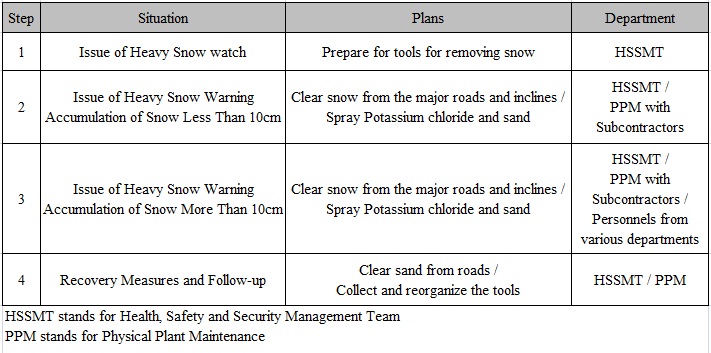Introduction - What we were interested in
On the first of January, there was a huge snow storm which Pohang has never experienced, at least in the last 60 years. The average snowfall was 24.5cm according to the Korea Meteorological Administration. In the aftermath, all flights were cancelled for two days, and the traffic was paralyzed.
POSTECH was not any different. On the day of the snow, most of the sidewalks were covered with snow; people had to make their own ways through it. The roads were in the same condition. As the first measures, a few heavy equipment vehicles were leased to remove the snow, but newly fallen snow covered the old piles making all the hard work useless.
With the good factors that the historical snowfall gave us, such as beautiful scenery, artful student-made artifacts and stronger femoral muscles to walk, it still taught us the importance of the existence of the school’s system to overcome such acts of nature. The Health, Safety and Security Management Team (HSSMT) was in the center of the recovery process.

Manual for Lighter Hit
As the table indicates, we have a concrete manual for small natural disasters that happened in the past, but not for unpredictable natural disasters such as an earthquake or possibly heavier snowfall. The reason is that such unpredictable natural disasters neutralize the concreteness and rather make work difficult. In such disasters and also in this snowfall we had, Yang Young-Seon, the director of HSSMT, said that we practice and practiced the organic cooperation between the departments. The main point is flexibility. There are thousands of natural disasters. We cannot have a manual for each; however, if we have a flexible cooperative system between departments, any disaster can be treated.
HSSMT basically takes the short-term job of primary emergency recovery such as clearing of essential roads to run the school. The Physical Plant Maintenance Department takes the long-term job of gradually clearing the streets and sidewalks. The Finance and Accounting Department backs up the funds needed for the recovery and additional costs. The Welfare Facilities Department checks the food supply for the school and dorms.
Details of What Went on in HSSMT: Interview of Director of HSSMT
I came to POSTECH in 1986. When it snows in Pohang, it usually just melts before it gets down and piles up. It snowed 10cm three years ago. No one, including me, predicted this heavy snowfall of 28.7cm.
At 3 PM the National Emergency Management Agency issued the disaster warning. By the time we also recognized the snow had been falling for too long, so we leased more diggers from Daegu and Busan. It was three times as expensive as usual. Also, we used approximately of 100 bushels of potassium chloride.
We have a projector right here to update the weather conditions from the Navy and the real-time CCTVs which allow us to watch the campus as a whole. None of the personnel in our team went home during the situation. We continuously monitored the campus and made efforts to clear sidewalks and roads. All subcontractors were busily mobilized for more than a week to neutralize the immobilized campus.
We used around 13 million won in the emergency recovery. Part of that was from a planned budget, but some was added.
Unfortunately, the manual did not have any protocol on for when the school should be closed. Even on the day of the snowstorm, many professors and students who live outside of the school must have had difficulty in coming to the campus. There probably needs some reflection.
Closing
As accentuated, setting up a concrete manual for bigger unpredictable disasters, which do not normally happen in nature in Pohang, is not very effective. There are various types of natural disasters. The production of manuals for all is inefficient and will not work anyway. In substitution, we have more flexible and systematic collaboration. That is the direction that HSSMT pursues.
To close the feature, there were some complaints that criticized the school not removing snow in front of their dorms or labs. The related school departments set the bigger chunks as the priority. This implies that getting rid of snow right in front of each front-yard or small pavements in a second would be difficult. Sometimes taking care of our own front-yards might help us have more beautiful campus life.


